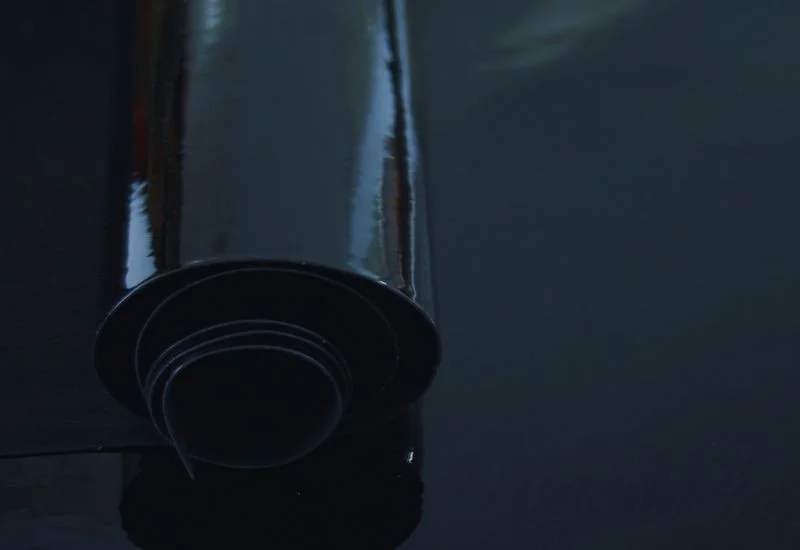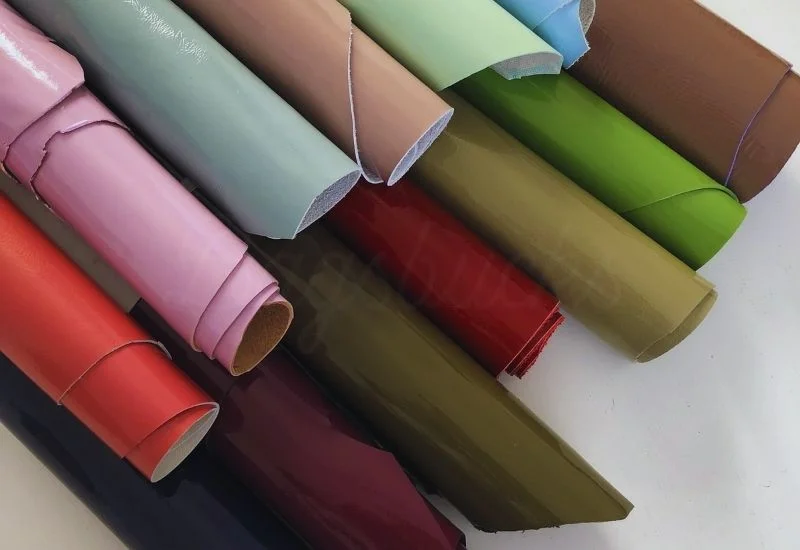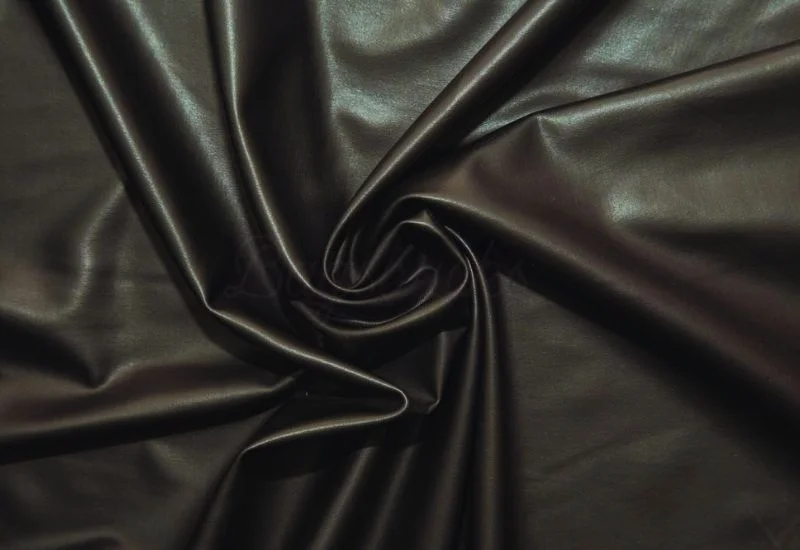
Edited by Abdullah Faraz on July 27, 2024
If you stroll down a busy street, you will see shimmering and lustrous leather products that outshine any other product due to their glossy appearance. They make you think about them all day.
This unique finish has been popular for centuries and is found in various products, including shoes, bags, wallets, and other accessories.
In this article, we will explore why patent leather has a shiny appearance, its production process, its pros and cons, and its real-world uses.
Let’s delve in and explore it together.
History of Patent Leather

Patent leather is a historical product that dates back to the 18th century. Early in England, the inventors received a patent for a shiny, glossy leather material, later known as patent leather.
Seth Boyden is the first in the list of patent leather manufacturers. It all started when he received a shiny leather piece from Germany. He developed a methodology to fabricate the glossy appearance using lacquer coating, which was obtained from a mixture of linseed oil.
After conducting several experiments with the linseed coating solution, he developed a method for producing patent leather. He became the first person to produce patent leather in America. He never claimed the manufacturing process and hence a lot of people use it to produce shiny leather material.
As time passed, patent leather became popular and found its use in various unique and stylish fashion and footwear accessories. Nowadays, it has become a symbol of luxury and elegance1.
Manufacturing of Patent Leather

Fabrication of patent leather is not a single-step process. It involves a series of steps that give it a shiny appearance. Both natural and artificial chemicals are present to synthesize different kinds of patent leather.
Curing of Hide
After leather arrives at the factory, it is cured to avoid putrefaction. This reduces the time for bacterial proliferation on the leather. Continuous removal of water from the leather is necessary to store it for long periods.
Conditioning of Leather
In this method, the initial step is to remove excessive salt from the leather. This is done by soaking the leather in specific containers filled with water and chemicals. This minimizes the growth of fungal and bacterial organisms on the leather.
Calcium hydroxide solution, also known as lime-milk solution, is preferable for removing hairs, keratin, and fats from the leather. This step is called liming. Later, the leather is softened by the bating process. An enzymatic solution is used to make it smooth.
Tanning
This step involves the treatment of animal hides with a solution of salt, oil, and lime to make them susceptible to becoming patent leather. Different chemicals and methodologies are adopted to form the patent leather2.
The patent finish is an important step in the manufacturing of patent leather. Both natural oils and synthetic materials are usable to make it look shiny. A mixture of acrylic and polyurethane gives a patent finish to the leather.
Polyurethane and acrylic each serve different functions in this process. Polyurethane provides shine and hardness to the leather, while acrylic is suitable for ensuring the flexibility of patent leather. Creating a homogenous ratio between the two chemicals is challenging and important as well.
Coating
A layer of translucent protective coating on the patent leather is essential to give it a glossy finish. After coating, buffing, and polishing the outer surface, the shine of the leather increases. It is necessary for leather’s endurance to shine.
The degree of shine is a variable factor that depends on the manufacturer. You can decide how much shine you want in your products. Buffing time is adjustable according to the requirement.
Buffing and polishing steps give the leather products a consistent and durable shine.
Uses of Patent Leather

For fashion-forward individuals, it is a thing of beauty. It is durable and easy to care for, and that’s why a lot of people opt to purchase this leather material. Its shiny and luxurious finish enables its use in many formal accessories like handbags, shoes, or wallets.
Let’s look at some accessories formed by using patent leather;
Bags
Various kinds of bags are in production using patent leather. Whether it is a handbag, shoulder bag, or crossbody bag, it attracts customers because of its unique appearance. It makes the bags luxurious, adding a sense of shine and softness.
The bags’ shiny appearance protects them from dirt, oil, and other materials that may harm the surface. Polishing the bag gives it a glossy appearance that lasts forever.
Shoes
Footwear is the most common accessory people purchase because of its glossy appearance. Patent leather is the reason behind the shine. Before the outburst of this type of leather, shoemakers cleverly used this leather material to make expensive wedding and dance shoes. It is also usable in formal shoes.
Shoes are fabricated using a number of materials, including rubber, plastic, leather, and polymers. Patent shoes are incredibly safe and durable. Men’s tuxedo wear and women’s shiny heels are essential products made of lacquer that gives them a glossy look, making them perfect according to the occasion3.
Clothing
With technological advancement, many wearable patent leather items are available in the market. A comprehensive knowledge of the fabrication process is essential for accurate results.
Many layers of leather are combined and sewn to make it durable. Later, the manufacturing process is concluded with a glossy appearance. This material produces long-lasting and thin jackets, women’s shirts, skirts, and other wearable items.
Due to its uniqueness and trendy appearance, it represents women’s culture and strengthens their position in Western society.
Advantages of Patent Leather
Patent leather has many unique features that differentiate it from other leather materials. The characteristics of this leather are due to the many features that it possesses.
The choice of patent leather depends on various advantages, some of which are as follows;
Waterproof
This ability of patent leather is due to polishing the external layer using oils or synthetic materials. The protective coating repels dirt and debris, along with the water that covers the items. It is noteworthy that this solely depends on the nature of the coating material and not the leather itself.
Durable
The coating is the most generic property of leather and is essential to protect it from wear and tear. It protects leather products from stains, scratches, and dyes. It makes patent leather products durable for a long time, making them a perfect investment.
Low Maintenance
It is easy to care for patent leather products, especially shoes and bags. Its smooth texture makes it easy to clean and maintain for a long time. It does not need polishing to remove stains as the protective layer helps in covering these aspects of leather.
Just take a damp, clean cloth, and you are good to clean the bag. It is excellent for people with busy schedules.
Versatile
Patent leather is the epitome of glamor and luxury in various leather products. The use of this leather with other materials increases the authenticity of the products. Its versatile nature makes it usable in a number of products like shoes, wallets, bags, jackets, etc.
It comes in various colors and designs that make it suitable for any kind of style. It is highly preferable to wear any attire during formal and casual events.
Glossy Appearance
The use of polyurethane or natural oils during the synthesis of patent leather gives the products a characteristic glossy appearance. It is responsible for attracting a number of customers.
Due to its unique appearance, it is usable in various products including handbags, formal shoes, and clothing products. Its essential feature is that the visual effects of a product are challenging to replicate, which makes it stand out from other relevant products4.
Disadvantages of Patent Leather
Scratches and Scuff
Scratches and creases develop on the surface of patent leather. They are removable to some extent, but hard scratches leave permanent marks on the leather’s surface.
It affects the shine of the leather, later leading to the development of cracks on the external surface. It is an irreversible phenomenon and cannot be treated with leather care products.
Breathability
The lustrous shine of patent leather is due to the application of certain synthetic chemicals onto the leather surface. These chemicals close any pores present on the surface of leather, thus reducing the breathability of the leather products.
The decrease in airflow makes it challenging to wear patent leather products in humid areas.
Discoloration
Patent leather is susceptible to absorbing the colors of other products. So, try to place it apart from other products. Also, as time passes, the patent leather begins to degrade. It leads to the discoloration of leather products.
It occurs due to the high rate of exposure to sunlight. UV rays destroy the surface or patent by generating cracks on the leather surface.
No Patina
A characteristic shine develops on the surface after treating the leather with synthetic or natural materials. The surface is no longer porous, and it will not generate a patina over time. This is a downgrade of leather material for many individuals who love leather’s genuine and vintage look.
Stiffness
Patent leather is stiffer than other leather products, which is a turnoff for many customers. With time, it becomes softer, but when you purchase a patent leather product, it gives an uncomfortable vibe to many people.
Difference between Patent & Genuine Leather
| Characteristics | Patent Leather | Genuine Leather |
| Origin | Leather coated with synthetic materials | Stiff and less flexible |
| Texture | Natural leather products derived from animal hides | Rugged and natural grains |
| Durability | Prone to scratches and discoloration | Extremely durable |
| Maintenance | Easy to clean | Requires conditioning and cleaning |
| Flexibility | Stiff and less flexile | Flexible and easy to mold |
| Price | Usually expensive | Less expensive |
| Patina | No Patina | Develop patina with time |
| Uses | Apparel and shoes | Upholstery, apparel, shoes, furniture and saddlery |
Maintaining Patent Leather
Patent leather is easy to clean and care for compared to other leather materials. But if you want to maintain its glossy appearance for a long time, you have to care for it accordingly.
Below are some of the methods for maintaining, cleaning, or caring for patent leather products.
Cleaning of Patent Leather
One of the best ways to clean this type of leather is to clean it regularly with a sponge and damp cloth. Polish will not work on it due to its shiny appearance. The cloth will remove debris or dirt from the patent leather’s surface, making it look new.
Soap & Leather Conditioners
Rinse appropriately with a mixture of water and mild soap. It helps in removing hard stains from the surface of patent leather. Effective cleaning is necessary otherwise stains may destroy the overall look and feel of the leather products.
Usually, leather conditioners are unusable for patent leather cleaning due to their shiny outer layer. But you can use it to add more shine and luster to the product. Properly clean and polish the external surface for effective shine.
Harsh Chemicals
Avoid the use of harsh and abrasive chemicals, as they disrupt and distort the surface of leather materials. They damage the coating on the leather surface, resulting in the appearance of cracks or even the removal of the external surface due to degradation.
Handling of Patent Leather
You have to care for the patent leather products from any rough, edgy, or sharp surfaces, as they might scratch the surface of the leather products. The scratches and scuffs are not removable and destroy the look of leather products.
Storage of Patent Leather
Proper storage of patent leather products when not in use is beneficial. They should be stored in a cool, dry place away from direct heat sources and sunlight. Otherwise, they can cause discoloration or degradation of patent leather.
Do not try to fold or store the products in a small storage box. Doing so can cause permanent damage to patent leather products like shoes, bags, and wallets5.
SUMMARY
Caring for patent leather is simple yet essential for preserving its glossy appeal. Regular cleaning with a damp cloth and avoiding harsh chemicals are key. Proper handling and storage prevent damage, ensuring your patent leather items remain stylish and shining.
Environment Impacts
Several synthetic polymers and chemicals are utilized in manufacturing patent leather, which is a major cause of environmental pollution worldwide.
The drainage water released from leather industries contains many harmful chemicals and heavy metal ions, which destroy the natural habitat of living things.
The use of machinery on a larger scale, along with the use of fossil fuels, causes a lot of air pollution. Manufacturing patent leather products takes a lot of effort and energy.
Major industries are shifting towards genuine leather to make cost-effective, natural leather products. This is beneficial as genuine leather degrades over time because it is a by-product of natural sources.
If you want to conserve energy and make the earth greener, utilize products made of natural materials. It will automatically reduce the production of synthetic products that are destroying the planet.
Conclusion
Patent leather is manufactured by tanning and polishing animal hides. This process gives the leather surface a characteristic shiny appearance. It is also water-resistant, easy to maintain, and requires less attention.
It is often used in footwear, apparel, and other accessories because it provides durability and a high fashion sense. It significantly outlasts other leather materials.
In this article, we have covered all the essential facts about patent leather that a consumer must know before purchasing a leather product.
Frequently Asked Questions
Article Sources
Bagsbucks provides reliable information with good-quality references to support the facts.
- The history of Patent leather. Ruico
↩︎ - Patent Leather: History, Different Types, and Benefits. Steel Horse Leather ↩︎
- Patent Leather: We Answer All Your Concerns. Elegant Oxford
↩︎ - Patent Leather – How It’s So Shiny, Waterproof, & Versatile. Liberty Leather Goods
↩︎ - How do I clean and care for patent leather shoes? Crease Beast ↩︎
